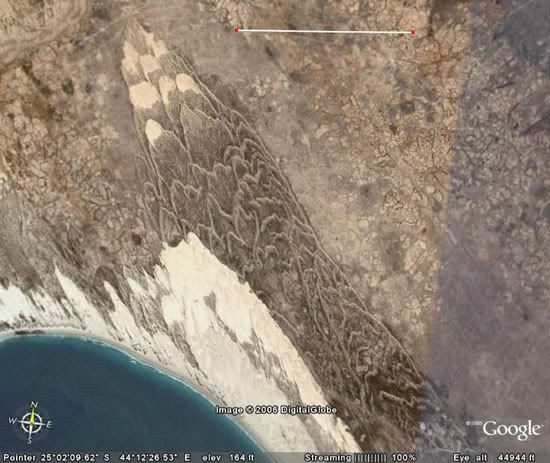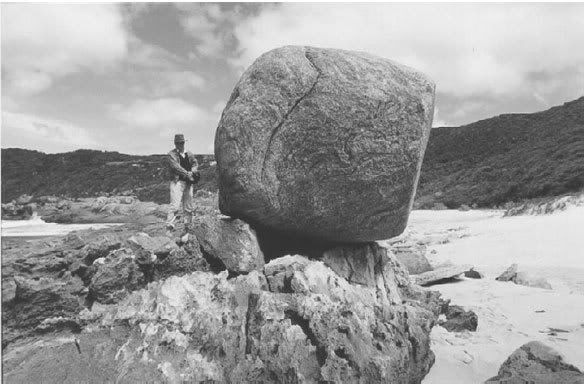Update: Further developments in this story can be found here.
It seems like megatsunamis are back in vogue, but this time a different culprit is in the frame. Around the turn of the millennium a lot of publicity was given to the suggestion that a 200 cubic kilometre-sized chunk of the western flank of Cumbre Vieja, an active volcano on La Palma in the Canary Islands, was poised to fall into the sea in a future eruption. Modelling suggested such a collapse would send a gigantic tsunami racing westward across the Atlantic, and the eastern seaboard of the US would be assaulted by 50 m high waves that would penetrate up to 20 km inland (for comparison, the Boxing Day 2004 tsunami produced waves 20-30 m high which penetrated 2-3 km inland on the Sumatran coast, a mere 160 km away from the epicentre).
This apocalyptic scenario was put forward by Bill McGuire and his colleagues at the Benfield Hazard Research Centre. McGuire has become the go-to guy when you want a geological scare-quote for your breathless documentary about how we’re all doomed, whether by megatsunami, supervolcano, or some other hyperbolically titled geological phenomenon. Here in Southampton, some people who have studied past collapse events in the Canaries think that the risk is being a tad…overhyped (see also here for the Benfield team’s counterargument, because you seem to get a series of much smaller landslides rather than one big one which will wipe out the whole of Western Civilisation.
Now Phil calls our attention to an article in the New York Times (free registration required) which highlights another potential source for really big waves - oceanic asteroid impacts, which a group of scientists led by Dallas Abbott have proposed as the source of some interesting wedge-shaped deposits, referred to as ‘chevrons’, you find on some shorelines, particularly around the Indian Ocean. Firing up Google Earth, we can find them on the West Australian coast (the line on this and the following images is 5 km long:
and here are the stars of the NY Times article, in Fenabosy bay, Madagascar:
and some similar structures I’ve spotted on the east coast of South Africa:
From a distance the chevrons resemble large dunes, but when you look closer things don’t fit. Studies of the Australian chevrons (see here and here) reveal that although they’re largely made up of sand, they also contain shell debris and cobbles (clasts of rock about 10-20cm in diameter), and sometimes are associated with much larger boulders, which appear to have been transported a considerable distance.
These observations are consistent with the chevrons being formed by a violent surge of water – a storm surge or a tsunami – sweeping the shells and other marine material inland. The strength of current required to transport the large boulders, and the distances inland (several km) and height above present sea level (10s of m) this material now crops out, have led some people to favour a tsunami origin.
So where do the asteroids come in? Look at this animation of the propagation of the Boxing Day 2004 tsunami (for those with lots of bandwidth, go here for the high resolution Quicktime version), and compare the wave directions radiating away from the Sunda Trench with the orientation of the chevrons found around the Indian Ocean. It’s clear that the former cannot cause the latter, so the chevron-causing tsunamis were not generated by subduction zone earthquakes (all of the other plate boundaries in the Indian Ocean are spreading ridges). Even if the orientation wasn’t wrong, the size of wave required to form structures on the scale of the chevrons dwarfs even the tsunami generated by the magnitude 9.2 earthquake two years ago.
Hence we need another source, and Abbott and the other members of the ‘Holocene Impact Working Group’ reckon that source is an asteroid impact, specifically the one which formed the 18-mile wide Burckle Crater, located in the centre of the Indian Ocean (31°S, 61°E). To support this hypothesis, they cite analysis of some of the marine fossils found in the Madagascar chevrons, which are fused with metallic flecks enriched with elements common in chondritic asteroids but rare in the Earth’s crust (as Lab Lemming explains rather better than the NY Times article).
This is not the only recent large impact Abbott and her colleagues have proposed – you can find chevrons on the eastern coast of Australia and southern New Zealand which they’ve linked to a crater on the New Zealand continental shelf. That’s at least two major impacts in the last 10,000 years, which is a bit at odds with the current estimated frequency calculated from astronomical surveys of near-earth asteroids.
In the midst of this contradiction, then, it is worth noting that the evidence is still slightly ambiguous. From the information I can find online there is reasonable evidence that at least some of the chevrons are caused by tsunamis, but the orientation of many of the Australian chevrons seems a little too north-south to be obviously traced back to Burckle Crater, which is almost directly to the east; and in the second of the two papers I linked to above, carbon dating of coral and shell debris in the chevrons suggests that together they record at least three events, roughly 700, 2000 and 6000 years ago - Burckle Crater is thought to be about 5000 years old - rather than one big event, although this may be complicated by reworking of older debris. Perhaps, then, we are looking at evidence for a number of smaller impacts, perhaps mixed in with submarine landslides, rather than a single big one forming all the chevrons. Such an interpretation would probably be more consistent with the astronomical data – there’s probably more uncertainty in impact rates of smaller asteroids, as they’re harder to spot (while we’re on that subject, it seems that estimates of the size of tsunami generated by an impact of a given size vary widely, which introduces additional uncertainties) . However, only time, and some careful dating work, will tell.
25 November, 2006
Return of the Megatsunami
Posted by
Chris R
at
5:00 pm
![]()
Labels: geohazards, geology
Subscribe to:
Post Comments (Atom)




2 comments:
And of course the brilliant (watch the credits and the scenes in Mission Control closely (or go to imdb.com) to see why I love this movie) "Deep Impact" provided a fairly realistic assessment of the damage from impact-generated tsunamis. Of course, many scientific liberties were taken in the movie, but all in all it was far more realistic than any other dramatization to touch on this subject.
A fascinating post, Chris. I shall now have to spend a few hours scouring the coastline in Google Earth looking for these things.
Post a Comment